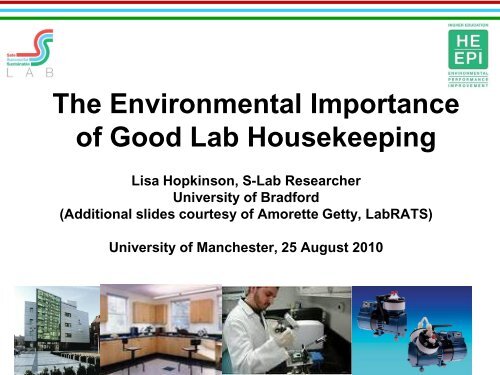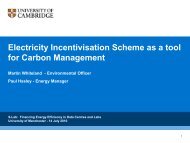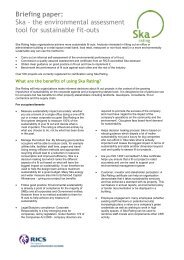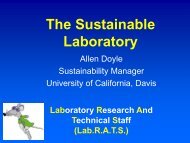Good Lab Housekeeping - Event Link
Good Lab Housekeeping - Event Link
Good Lab Housekeeping - Event Link
You also want an ePaper? Increase the reach of your titles
YUMPU automatically turns print PDFs into web optimized ePapers that Google loves.
The Environmental Importance<br />
of <strong>Good</strong> <strong>Lab</strong> <strong>Housekeeping</strong><br />
Lisa Hopkinson, S-<strong>Lab</strong> Researcher<br />
University of Bradford<br />
(Additional slides courtesy of Amorette Getty, <strong>Lab</strong>RATS)<br />
University of Manchester, 25 August 2010
Why Environment is<br />
Important<br />
Regulation<br />
•Display Energy Certificates<br />
•Carbon Reduction Commitment<br />
•REACH<br />
Stakeholders<br />
- HEFCE 80% carbon reduction<br />
Cost<br />
-Cuts and Devolved budgets
<strong>Lab</strong> Environmental Impacts<br />
Energy<br />
•HVAC<br />
•Equipment<br />
Water<br />
Chemicals/materials<br />
Waste – incl. hazardous<br />
Space
Safe, Successful and<br />
Sustainable <strong>Lab</strong>s (S-<strong>Lab</strong>)<br />
3-year centrally funded project<br />
UK university labs more sustainable<br />
Sharing good practice – events, case studies<br />
<strong>Lab</strong> audits and assessments<br />
http://www.goodcampus.org/s-lab/index.php
Total Unnorm Energy kWh/m2<br />
1200<br />
1000<br />
800<br />
600<br />
400<br />
200<br />
0<br />
Bioscience Energy Use<br />
test<br />
Brad<br />
Bath<br />
Ox<br />
Ox<br />
Ox<br />
Warw<br />
Cam<br />
Cam<br />
Ox<br />
New<br />
QMU<br />
Ox<br />
Ox<br />
StAn<br />
Unnorm FF kWh/m2 Unnorm Elect kWh/m2<br />
Ox
<strong>Lab</strong>oratory Energy Auditing and<br />
Footprinting (LEAF)<br />
•Provide info on pattern of energy use in different<br />
labs<br />
•Identify and stimulate improvement actions<br />
Liverpool (Biosciences), Manchester (Chemistry)<br />
Edinburgh (Biosciences) and York (Biology)<br />
Final results expected Autumn 2010
LEAF Initial Findings (Bio)<br />
Lighting &<br />
small power<br />
10%<br />
Cooling<br />
15%<br />
Equipment<br />
30%<br />
Heating<br />
5%<br />
Ventilation<br />
40%
HVAC Energy Costs<br />
•‘Millionaire’ laboratories<br />
- Oxford Chemistry lab £1.2 million pa<br />
•Typical Constant Volume Fume<br />
Cupboard running 24/7 uses ~2-3kW<br />
•Equals 1-2 typical houses or >£2,000/y
<strong>Lab</strong> Assessments<br />
•Self-assessment tool inspired &<br />
adapted from <strong>Lab</strong>RATS in US<br />
•Currently being piloted in UK<br />
•<strong>Lab</strong>-specific and building assessments<br />
•Contains improvement suggestions<br />
•<strong>Link</strong>s to best practice
<strong>Lab</strong>RATS<br />
A program developed by and for researchers<br />
and support staff to directly address the unique<br />
challenges and opportunities to reducing the<br />
environmental impact of laboratories.
Who is <strong>Lab</strong>RATS?<br />
Researchers<br />
Administrators<br />
Student Interns<br />
Facilities Staff
The Challenges<br />
• Myth: Research can‟t be effective and safe<br />
without its current consumption level<br />
60,000 gallons of water saved in<br />
one year by making a minor<br />
modification on the set-up of<br />
this still.
<strong>Lab</strong><br />
Environmental Impacts<br />
Energy<br />
•HVAC<br />
•Equipment<br />
Water<br />
Chemicals/materials<br />
Waste – incl. hazardous<br />
Space
Energy – HVAC Opportunities<br />
•Close VAV sashes<br />
- monitor and report performance<br />
•(Safely) „tweak‟ parameters<br />
- flow rates; temperature and humidity control bands<br />
•Switch off/turn down HVAC “out of hours”<br />
- zone proximity sensing (ZPS)<br />
•Upgrade equipment<br />
- variable speed drive motors
Harvard – Sash Closing
Fume Hood Sticker<br />
• Safety approved<br />
• “Red Zone Compliant”<br />
<strong>Lab</strong>s<br />
• Record sash positions<br />
during inspection<br />
• Diversity to 10-20%?
Nottingham Case Study<br />
380 fume cupboards<br />
linked to BMS -<br />
calculate average sash<br />
heights<br />
Monthly reports sent to<br />
lab users, with estimate<br />
of energy savings<br />
compared to their<br />
running 24/7
<strong>Lab</strong><br />
Environmental Impacts<br />
Energy<br />
•HVAC<br />
•Equipment<br />
Water<br />
Chemicals/materials<br />
Waste – incl. hazardous<br />
Space
Chemistry – Big Energy Users<br />
•Ovens<br />
•Hotplates/heater-stirrers<br />
•NMR<br />
•Mass spectrometers<br />
•Rotary evaporators<br />
•Glass washers<br />
•Water baths
Biosciences – Big Energy Users<br />
•Controlled environmental chambers<br />
•Freezers (-80 and -20)<br />
•Ovens<br />
•Incubators<br />
•Icemakers<br />
•Autoclaves<br />
•Mass spectrometers<br />
•Laser microscopes
Equipment Energy<br />
Opportunities<br />
•Switch off/power down when not<br />
required<br />
•Avoid cooling/heating conflict<br />
•Procure energy efficient<br />
equipment<br />
•Group high loads<br />
•Better sample storage<br />
management
-80 Freezer Energy Use<br />
Daily Energy Use (kWh)<br />
70<br />
60<br />
50<br />
40<br />
30<br />
20<br />
10<br />
0<br />
570L 725L 585L 760L<br />
Capacity (L)<br />
Data Supplied by University of Newcastle<br />
Min<br />
Ave<br />
Max
-80 Freezer Running Costs<br />
For 725L freezer:<br />
Energy ranged from 6,000 – 21,000 kWh/y<br />
Costs ranged from ~£500 - £1800/y<br />
Difference = £1300/y PER FREEZER!<br />
•Procure Energy Efficient Freezers<br />
•Energy Star label for <strong>Lab</strong> Grade freezers<br />
Data supplied by University of Newcastle
Newcastle Case Study<br />
•£180,000 of central funding to replace old<br />
lab fridges/freezers<br />
•36 -80 freezers replaced saved 137,000 kWh,<br />
or 70 tCO 2<br />
•Also reduced space, increased reliability,<br />
more £ for research
Case Study<br />
– Blizard Institute<br />
•Improved sample tracking & management<br />
•Handheld barcode scanners and labels<br />
•Reduced no. frozen samples in dewars by 50%<br />
through better inventory management & disposal<br />
•Standardised containers - more efficient use<br />
• of space<br />
•Location tracking - sample retrieval quicker and<br />
easier
Sample Storage - Stanford<br />
•350 labs, 2,000 -80 freezers<br />
•Pilot found ~9-13 million samples<br />
could be stored at room temperature<br />
•3 to 5 year payback for investment<br />
•~ $11-20 million/y cost reductions<br />
•Greater reliability<br />
•More space
<strong>Lab</strong> Environmental Impacts<br />
Energy<br />
•HVAC<br />
•Equipment<br />
Water<br />
Chemicals/materials<br />
Waste – incl. hazardous<br />
Space
Water Opportunities<br />
<strong>Lab</strong>s consume ~ 1-3m 3 of water per m 2<br />
Typical lab of 5,000 m 2 = £12,000-35,000/y<br />
Sterilisers and autoclaves big water users<br />
Use closed-loop cooling water for equipment<br />
cooling<br />
Use non-potable water sources.<br />
Use vacuum pumps instead of aspirator<br />
fittings
<strong>Lab</strong> Environmental Impacts<br />
Energy<br />
•HVAC<br />
•Equipment<br />
Water<br />
Chemicals/materials<br />
Waste – incl. hazardous<br />
Space
Chemical Opportunities<br />
•Unused or duplicate chemical<br />
purchase common<br />
•Edinburgh’s chemical management<br />
system saved ~ 25% of purchase<br />
costs, equivalent to £100,000/y<br />
•Better stocktaking and regular<br />
audits<br />
• MIT Green Chemical Alternatives<br />
Purchasing Wizard,<br />
http://web.mit.edu/ENVIRONMENT/a<br />
cademic/purchasing.html
Toxic Chemicals can be…<br />
…eliminated.
Best Practices – Waste Management<br />
Mercury Thermometer Exchange<br />
• Highly Toxic<br />
• 809 thermometers collected<br />
• Saved $134/month in clean-up<br />
• Student-Funded<br />
• Intern staffed
Best Practices – Waste Management<br />
Surplus Chemicals<br />
• Interactive website; FREE<br />
• Active Outreach by Interns<br />
• Diverted 150 chemicals in approx. 1 year<br />
• Student-funded
Best Practices – Waste Management<br />
Minimize chemical volume<br />
Mini vials = 75% savings on cocktail and disposal.
<strong>Lab</strong> Environmental Impacts<br />
Energy<br />
•HVAC<br />
•Equipment<br />
Water<br />
Chemicals/materials<br />
Waste – incl. hazardous<br />
Space
Best Practices – Waste Management<br />
Salvage opportunities:<br />
Fittings rarely included; decontamination an issue.<br />
An untapped resource?<br />
Gas and vacuum valves Glass Drains: cleaned and ready
Best Practices – Waste Management<br />
Surplus Equipment Website<br />
• Photos of listed equipment<br />
• Property issues resolved before listing<br />
• Pick up directly from lab<br />
• Post by category; not mixed with furniture and<br />
hardware.<br />
• <strong>Lab</strong> coordinator notified by digest weekly
Equipment Opportunities
Summary<br />
•Numerous opportunities to reduce<br />
resources, costs and waste<br />
•Often improves safety<br />
•Research benefits<br />
•Needs a champion!






